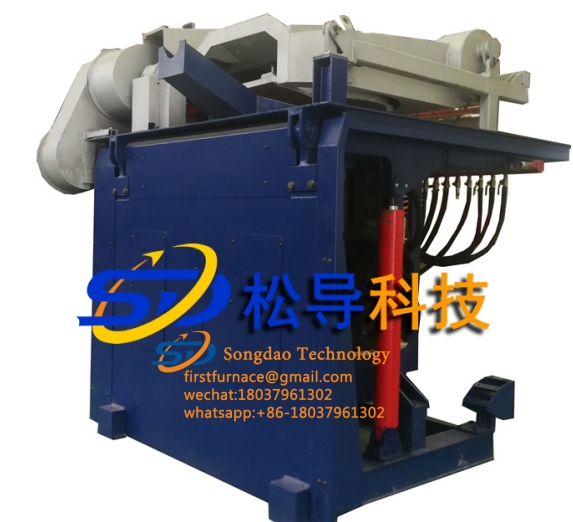- 31
- Mar
Која је разлика између индукционе пећи средње фреквенције и електролучне пећи?
Која је разлика између индукционе пећи средње фреквенције и електролучне пећи?
Although electric arc furnaces and intermediate frequency induction furnaces are commonly used cast steel smelting equipment in factories, intermediate frequency induction furnaces have the following characteristics in terms of refining capacity and adaptability compared with ordinary electric arc furnaces.
1. Особине у погледу способности оплемењивања
Electric arc furnaces are better than induction furnaces in removing phosphorus, sulfur and deoxidizing capacity. The induction furnace is cold slag, and the slag temperature is maintained by the heat provided by the molten steel. The electric arc furnace is a hot slag, and the slag is heated by an electric arc. Dephosphorization and desulfurization can be completed through the slag, and the slag is fully diffused and deoxidized. Therefore, the ability of electric arc furnace to remove phosphorus, sulfur and oxygen is better than that of induction furnace. The nitrogen content in electric arc furnace smelting steel is higher than that in induction furnace. This is because nitrogen molecules in the air in the high temperature zone of the arc are ionized into atoms and then absorbed by the molten steel. Induction furnace smelting alloy has a lower nitrogen content than an electric arc furnace, and a higher oxygen content than an electric arc furnace, and the alloy has a higher rapid life value than an electric arc furnace.
2. Висока стопа опоравка елемената од истопљене легуре
The yield of alloy elements smelted by induction furnace is higher than that of electric arc furnace. The volatilization and oxidation loss of elements are large under the high temperature of the arc. The burning loss rate of alloying elements in induction furnace smelting is lower than that of electric arc furnace. In particular, the burning loss rate of the alloy elements in the return material loaded with the furnace is much higher than that of the induction furnace. In the induction furnace smelting, it can effectively recover the alloying elements in the return material. During electric arc furnace smelting, the alloying elements in the return material are first oxidized into the slag, and then reduced from the slag to the molten steel, and the burning loss rate is significantly increased.
When returning the material to smelt, the alloy element recovery rate of the induction furnace is significantly higher than that of the electric arc furnace.
3. Ниско повећање угљеника у растопљеном челику током топљења
Индукциона пећ се ослања на принцип индукционог загревања да би се растопио метални пуњач без повећања угљеника у растопљеном челику. Електрична лучна пећ се ослања на графитне електроде за загревање пуњења кроз електрични лук. Након топљења, растопљени челик ће повећати угљеник. У нормалним условима, при топљењу високолегираног никл-хром челика, минимални садржај угљеника у електролучној пећи је 0.06%, а код топљења у индукционој пећи може да достигне 0.020%. Повећање угљеника у процесу топљења у електролучној пећи је 0.020%, а у индукционој пећи је 0.010%. Невакумска индукциона пећ средње фреквенције је погодна за топљење нискоугљеничних и високо легираних челика и легура.
4. Електромагнетно мешање растопљеног челика побољшава термодинамичке и динамичке услове процеса производње челика. Услови кретања растопљеног челика у индукционој пећи су бољи од оних у електролучној пећи. У ту сврху електролучна пећ мора бити опремљена нискофреквентном електромагнетном мешалицом, а њен ефекат још увек није тако добар као код индукционе пећи. Ефекат електромагнетног мешања у индукционој пећи побољшава кинетичке услове реакције и промовише хомогенизацију температуре и састава растопљеног челика. Међутим, прекомерно мешање неће допринети уклањању инклузија и оштећењу облоге пећи.
5. The process parameters of the smelting process are easy to control. The control of temperature, refining time, stirring intensity and constant temperature during induction furnace smelting are all more convenient than electric arc furnaces and can be carried out at any time. Because the induction furnace has the above characteristics, it is a relatively important position for comrades in the smelting of high alloy steels and alloys. It can produce products independently, and can also be combined with secondary refining such as electroslag remelting and vacuum self-consumption to form a dual process for production. Therefore, non-vacuum intermediate frequency induction furnace smelting has become an important smelting method for the production of special steels and alloys such as high-speed steel, heat-resistant steel, stainless steel, electrothermal alloys, precision alloys, and high-temperature alloys, and has been widely used.

